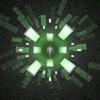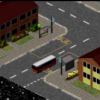Whelp.... My last attempt at spurring some conversation was a bit of a bust. Over 1000 views in 24 hours, which is amazing to me, but despite strongly encouraging people to say hello, not a single comment. I'm not angry or sad (okay, a teeny bit sad), but it does seem to indicate that people both here and elsewhere (I have tried the same in other fora) are passive consumers, rather than active participants. To me, that is a bit disheartening, because I love to hear other people's thoughts. Seriously, I would not be able to handle telepathy in a mature, respectful way, no sirree. But alas, I will poke people no more to speak their minds. Well, for now, at least. Cab driver, on to other topics!!
So, you may have noticed the small, discrete image at the entry to this post. That's a test image from my game. The top image is from the surface of a celestial body (technically, a star, but the same code should be able to generate planets, moons, whathaveyou), the bottom one is the same celestial body at a distance. The big deal here is the weird pattern of ever-shrinking polygons on the thing. They are, of course, the product of my new favorite word: Tesselation. Just say the word, feel it, it is goddamn beautiful. For the uninitiated, it simply means that when you close in on a polygon, it becomes more polygons, adding dynamic details as you get closer (and removing them again when you go farther away). Combined with my logarithmic layers of scale, this should allow me to create a graphics engine that can handle anything from subatomic particles in a fly's wing to galactic superclusters in one and the same scene. As stated in a previous blog entry of mine, one use is to create Shadow of the Colossus style kaiju monsters in the game. Or to go one step further and create intergalactic monsters like in Lovecraftian horror or comicbook ultra-supervillains, or even planet-eating mega-robots voiced by Orson Welles, without adding undue strain to the computer (it's running on an 8GB laptop at the moment). The current work-name for the project is the SDNM engine: Size Does Not Matter.
One thing that dawned on me in this was the question of "when does detail actually matter?". I like detail. If I could, I would make everything so detailed you could pick the little hairs off the edge of a blade of grass (go look closely at a big blade of grass, closely. Yes, you'll look like an idiot, but that stuff is complex!!). But that doesn't mean the details actually matter. Minecraft got along fine just on blocks, and retro or fake-retro graphics styles are popping up as a counterweight to the graphics overload of quote-unquote "tripple A" games. Detailed graphics rarely affect story, either. So why have them?
At this point, the argument of "well, it doesn't harm anyone" could be made. True, a game can fail because of overdependence on snazzy graphics and lacking priority on story and gameplay (No Man's Sky, many brown-n-grey shooters, etc.), but if the game is solid, the graphics are no harm, right? Most of the time, true. But there comes a point when details become distractions. Imagine if Super Mario had a busy city in the background, plummers and goombas running around to shop and socialize. The idea might be appealing, it would add a whole new layer of visual mood to an otherwise fairly simplistic game style. But the big advantage of Super Mario is the simplistic game style. You know where to go, when to jump, and anything unusual either sticks out clearly or is so truly hidden that you do not blame yourself for missing it. No distractions, just the game.
Push that to more modern games. Many games have whole towns to walk around, or even city districts (think Deus Ex), but most is just for show. we know, as players, not to expect to interact with much of it, at least not in a meaningful, productive way. But that means that game developers have to counter this level of detail with in-game symbolism to show what can be used, and what is just for show. If we increase that level of detail, at what point do the cardboard setpieces outshine the actual, useful game content? When will half a game involve running through a city of pretty-but-useless background fluff, just to find the one shop or contact that actually has game value?
I'm not at that level yet, not even anywhere near it. But I'm already having similar concerns. My SDNM engine structure lets me create millimeter detail on anything the player can see close enough (technically, it can do it for distant objects, as well, but that is of course pointless). But how much of that would be nothing but distraction? Like the procedural universe of No Man's Sky, how long would it take for that level of detail to become the gimmick that drowns out any work towards creating gameplay? I am sure most of us face a similar problem, in that we let the giddiness of coding something unusual cloud our minds and make us forget to actually make a game. But even if we make the game, with great gameplay, could the level of detail distract players so much that it drowns out the game itself? Where does the line go between level of detail and level of distraction?
I have no answer. Honestly, it bothers me. If anyone has a stance, an argument, some random thought on the matter, please, do let me know (yes, I am trying to make people comment, again, but this is not the same pressure as before). If nothing crashes horrifically for me over the next few weeks, I will most likely be facing the question of "how much detail?" very soon, and having some things to keep in mind might not be all that bad....
Cheers, and don't be a stranger ;)






